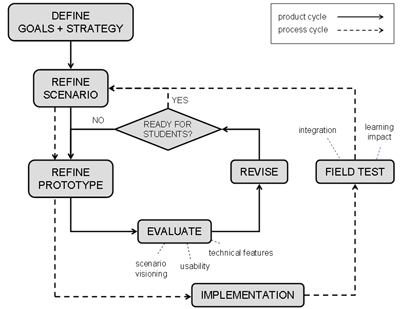Rapid prototyping (also rapid prototyping design, RAD) is a general design method.
See also: user-centered design and R2D2 (an other agile instructional design method).
1 The model
According to Joe Hoffman and Jon Margerum-Leys (HTML retrieved 29 May 2006), the general rapid prototyping model can be summarized as follows:
- concept definition
- implementation of a skeletal system
- user evaluation and concept refinement
- implementation of refined requirements
- user evaluation and concept refinement
- implementation of refined requirements
2 Rapid prototyping as instructional design method
Agile methods have been always very popular in education since this is how teachers operate in the classroom. However, until recently instructional design methods were rather dominated by heavier instructional systems design models.
2.1 Tripp and Bichelmeyer
Tripp and Bichelmeyer (1990: 36) define a model that presents “that occur in a rapid prototyping environment, when prototyping is specifically used as a method for instructional design. The overlapping boxes are meant to represent the fact that the various processes do not occur in a linear fashion. In other words, the analysis of needs and content depends in part upon the knowledge that is gained by actually building and using a prototype instructional system.”

Tripp and Bichelmeyer rapid prototyping ISD model
2.2 Lot Like Agile Methods Approach (LLAMA)
A model created and "sold" by Torrance eLearning. Unfortunately we only found videos that explain this method.
2.3 Successive Approximation Model
The Successive Approximation Model (SAM) was developed by Michael Allen and Richard Sites. There are two main versions:
- SAM1 for small projects: A Design - Develop - Evaluate loop
- SAM2 for larger projects: A three stage model: Preparation - Iterative Design - Iterative Development.
- Iterative Design includes a Design - Prototype - Evaluate Loops
- Iterative Development includes a Evaluate - Develop - Implement Loop
2.4 eLab Model
The eLab model considers fast prototyping as a communication "catalyst" that is particular suitable in situations where change management issues exist:
- It allows to promote the discussion within the project group in a focused way, by concentrating on the facts and the results, rather than on theories and prejudices against technologies.
- It will allow to build shared understanding among the different professionals involved in the project and builds trust: two important conditions for the success of the project.
The authors summarize their model with the following diagram:

The eLab prototyping model (Botturi, Cantoni, Lepori, Tardini 2007)
This design method:
- makes the design and development process open to new emerging ideas
- makes the design open to emerging needs from test and evaluation phases
- let's teachers focus on pedagogical design (teaching) instead of course materials preparation and technology
- stimulates discussion with external partners.
2.5 Discussion
Botturi et al (2007) identify three main issues one has to deal with, plus pitfalls to avoid
- Cost: “Fast prototyping costs. What is developed risks being rejected and 'demolished', even if in critical and fruitful demolition. In order to be cost effective, a sound ratio between prototype scale and the final product is needed; when this is not feasible, examples taken from other experiences may be used.”
- Shared understanding: “Fast prototyping is particularly helpful in order to provide a shared understanding of what the final e-learning course is likely to be; it offers the development team a common background where many misunderstandings can be avoided.”
- Training effect: “E-learning is a new world: it happens quite often that people working in course development do not have extensive experience. Fast prototyping provides them with a common language and an initial experience of e-learning.”
Botturi et al (2007) identify two pitfalls to avoid:
- “The first pitfall is the 'quick and dirty' effect, i.e. a very rapid, but low quality development may negatively affect further developments, hindering understanding, collaboration and commitment. The second one is just at the opposite pole in the 'speed' scale: the non-fast prototyping case. Here the prototyping phase is extended so much that it only delivers a late contribution, which often has to be accepted as time resources do not allow substantial revisions.”
3 Software
A lot, e.g. alone for the SCRUM method, Wikipedia lists over 15
Example:
4 Links
- In project oriented learning
5 References
- Allen, Michael W. (2012). Leaving Addie for SAM: An Agile Model for Developing the Best Learning Experiences, ASTD Press, ISBN 978-1-56286-711-9, Store
- Botturi, L., Cantoni, L., Lepori, B. & Tardini, S. (2007). Fast Prototyping as a Communication Catalyst for E-Learning Design. In M. Bullen & D. Janes (eds), Making the Transition to E-Learning: Strategies and Issues. Hershey, PA: Idea Group, pp. 266-283. PDF Preprint
- Tripp,Steven, Bichelmeyer,Barbara, Rapid prototyping: An alternative instructional design strategy, Educational Technology Research and Development, 38, 1, 3/18/1990, Pages 31-44, DOI 10.1007/BF02298246 (Access restricted)
- Luqi. (1989). Software evolution through rapid prototyping.Computer, 22(5), 13-25. Abstract / PDF
- Peter Rawsthorne, Cape Breton University & Memorial University of Newfoundland, Agile Instructional Design, PDF (from [1])